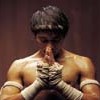Agam's Gecko


Thursday, November 08, 2007
MUSCULAR BUDDHISM
| I |
t's nice to see a big-media journalist drawing many of the same parallels I've been harping on here for the past few weeks. Andrew Higgins, writing in the Wall Street Journal (free article) examines a relatively recent phenomenon in Buddhism -- becoming a force for political activism. The obvious case is of course Burma, but as I've been saying a lot here lately, the Tibetan freedom struggle of the past half century has been driven by the same ideals -- liberation from suffering and oppression (and in the Tibetan case, foreign occupation).
With no tradition of crusade or jihad for God, and no scriptural mandate for revolt against unjust rulers, Buddhism has nevertheless become an agent for change in Tibet and Burma, and elsewhere in Southeast Asia. But this is something relatively new for the Buddhist faith, which teaches nothing about God but instead focuses on a way of life which can conquer human desires, the source of suffering. During its more than two and a half thousand year history Buddhism has tended to reinforce the status quo, with justice for evil-doers to be expected via karmic law in their next life.
But as a member of Burma's government in exile told Andrew Higgins, "We can't wait." When the protests began in August, organised by political activists seasoned in the Generation 88 movement and joined by ordinary citizens, most were arrested and the protests died down. Then security forces made their first mistake by using violence against monks in Pakokku at the beginning of September. When the Sangha asked for an apology, they were ignored. The monkhood was galvanized.
In contrast to secular activists, who are often easily silenced by arrests and intimidation, these faith-fired Buddhist campaigners have demonstrated tremendous stamina. Such perseverance is often helped by the fact that monks and nuns usually have no spouses or children to worry about. Activists also benefit from a loose but durable support network provided by their faith.Higgins met U Zawtiga, a monk from Rangoon now in hiding along the Thai border area.
"Everybody knew the military would use violence," he says. "This was not unexpected. We are not afraid." Students and other pro-democracy forces, he says, have been severely weakened by years of repression but "the Sangha [Sanskrit for Buddhist clergy] is getting stronger and more organized."For some observers (myself, for one), the parallels with another freedom struggle were not too difficult to see.
One of the better-known demonstrations of stalwart Buddhist resistance is in Tibet, a Buddhist theocracy until China invaded in 1950. Its monks again defied Beijing last month by celebrating the U.S. Congress's decision to award its highest civilian honor to the exiled Dalai Lama. Clashes were reported in several towns between Chinese security forces and monks.China's communist rulers also have a formidable opposition within China proper, despite their crushing of the secular pro-democracy movement 18 years ago. Falun Gong is a meditative sect which stresses personal responsibility and perseverance, with its roots in Chinese folk religions, Buddhism and some "pseudoscience" from its founder Li Hongzhi.
Though often wary of Falun Gong's sometimes cultlike behavior, secular Chinese dissidents voice admiration for its staying power. Democracy campaigner Wei Jingsheng, who spent 19 years in Chinese prisons and now lives in exile in the U.S., isn't a believer but sometimes attends Falun Gong events outside China to show solidarity. At a big July rally in Washington, he looked out on a sea of anti-communist banners and said his own dwindling band of secular democrats "could never get a crowd like this."Since the time of King Asoke, who more than two thousand years ago declared Buddhism the state religion in what is now India, Asian rulers have sought a "priest - patron" relationship with their Buddhist clergy. This relationship, called "cho-yon" in Tibetan, forms part of the basis for China's communists to claim perpetual sovereignty over the former lama-ist state -- that Tibet had "always been part of China." What they wish the world to infer from cho-yon is the supremacy of the emperor (the patron) over Dalai Lama (the priest). This is why they'll never tell you what happened when the latter went to visit the former. The emperor had to travel outside his capital, and receive the Tibetan monarch with a bow of obeisance before escorting him inside.
Burmese tradition says that Buddhism was brought into the country by a mission from King Asoke in the 3rd century B.C., about a thousand years before Guru Rinpoche (Padmasambhava) brought the teachings from India into Tibet. The Chi-Coms are still annoyed about that, destroying monuments to him as recently as barely over a month ago.
Higgins' article is well worth reading in full. It's a well-informed, and informative look at modern Buddhist activism. He has clearly been paying attention to recent events, and gives the best short summary of the way things developed in Burma over the past months, of any that I've seen.
He also offers some very interesting but little-known facts. For example, even fanatical atheists can be tempted to use borrowed Buddhist symbolism. It was news to me that Cambodian genocidist Pol Pot, while in retreat with his henchmen within Phom Penh's Silver Pagoda (planning his murderous campaign to rewind Cambodia's calendar to the Year Zero), would sleep on a pedestal that had originally held a statue of the Buddha.
Higgins also has a very fine gallery of photos from eastern Burma, Dharmsala and elsewhere.











 Our way of saying "thanks" in the Thai way. Here a nak muay Thai (kickboxer) offers respect and thanks for his teacher (wai khru) before a match. This is our local variation on the ubiquitous "hat tip" used in general blog culture.
Our way of saying "thanks" in the Thai way. Here a nak muay Thai (kickboxer) offers respect and thanks for his teacher (wai khru) before a match. This is our local variation on the ubiquitous "hat tip" used in general blog culture.





